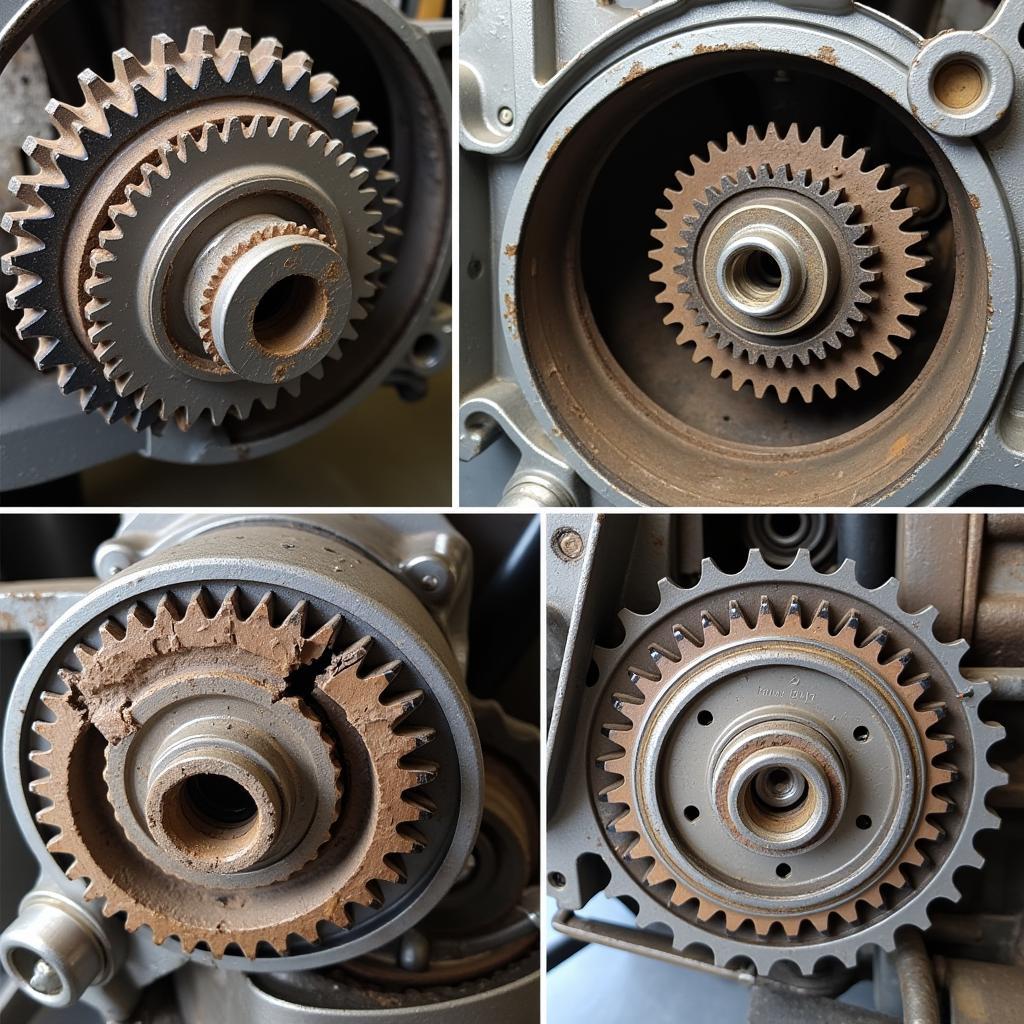A problem with your car’s reverse gear can be frustrating and inconvenient. It can make it difficult to park, back out of driveways, or even maneuver in tight spaces. This article will guide you through the common causes of reverse gear problems, diagnosis tips, and potential solutions.
Common Causes of Reverse Gear Problems
Several factors can contribute to issues with your car’s reverse gear. Here are some of the most common:
1. Transmission Problems:
- Damaged Reverse Clutch Pack: This is a common culprit in automatic transmissions. The reverse clutch pack is responsible for engaging the reverse gear. Wear and tear, or even failure, can prevent it from working properly.
- Faulty Transmission Fluid: Dirty or low transmission fluid can cause friction and impede proper gear shifting, including reverse.
- Solenoid Issues: In some transmissions, solenoids control gear selection. Malfunctioning solenoids can prevent the reverse gear from engaging.
- Internal Transmission Components: Damage to internal transmission components, such as gears or bearings, can lead to problems with reverse and other gears.
2. Electrical Problems:
- Faulty Reverse Switch: This switch signals the transmission to engage reverse gear. If it’s damaged or malfunctioning, your car might not go into reverse.
- Broken Wiring: Wires connected to the reverse switch or transmission can become damaged, leading to a faulty signal or a complete lack of electrical connection.
- Short Circuit: A short circuit in the wiring can also disrupt the signal to the transmission, preventing reverse gear engagement.
3. Mechanical Problems:
- Damaged Drive Shaft: A damaged drive shaft can prevent power from reaching the rear wheels in reverse.
- Broken Transmission Mount: A broken transmission mount can cause the transmission to shift out of alignment, preventing reverse gear engagement.
 Damaged transmission gears and components
Damaged transmission gears and components
Diagnosing the Problem
Before diving into repairs, you need to accurately diagnose the issue. Here are some steps you can take:
1. Check Transmission Fluid Level:
Ensure the transmission fluid level is within the appropriate range. Low fluid can lead to slipping and other issues.
2. Listen for Unusual Noises:
Pay close attention to any unusual sounds like grinding, clunking, or whining, especially when trying to shift into reverse.
3. Test Electrical Components:
- Reverse Switch: Inspect the reverse switch for damage or corrosion. You can test its functionality with a multimeter.
- Wiring: Visually inspect the wiring for any breaks, damage, or loose connections.
4. Check for External Issues:
- Drive Shaft: Inspect the drive shaft for signs of damage or leaks.
- Transmission Mount: Examine the transmission mount for cracks or looseness.
5. Seek Professional Assistance:
If you’re not confident in your ability to diagnose the problem yourself, it’s essential to take your car to a qualified mechanic. They have the expertise and tools to accurately identify and repair the issue.
 Car on a lift undergoing inspection by a mechanic
Car on a lift undergoing inspection by a mechanic
Troubleshooting Tips
While a qualified mechanic is best for diagnosing and repairing complex transmission issues, here are some simple tips you can try:
1. Restart the Car:
Sometimes, a simple restart can resolve temporary electrical issues.
2. Clean the Reverse Switch:
If the reverse switch is dirty or corroded, cleaning it might restore functionality.
3. Check and Replace Transmission Fluid:
Ensuring the transmission fluid is clean and at the correct level is crucial for optimal transmission performance.
 Checking transmission fluid level using a dipstick
Checking transmission fluid level using a dipstick
Professional Advice
“A common problem with reverse gear issues is a failing reverse clutch pack,” says John Smith, a certified mechanic with over 15 years of experience. “If you suspect this, it’s best to have a mechanic inspect and potentially replace the clutch pack.”
“Electrical problems are also frequent,” adds Sarah Jones, a transmission specialist. “Checking the reverse switch and wiring is a good first step in diagnosing electrical issues.”
Conclusion
A reverse gear problem can be a significant inconvenience. While some issues might be minor and easily fixed, others require professional diagnosis and repair. Remember to check your transmission fluid level, listen for unusual noises, and inspect electrical components. If you’re unsure about the cause of the problem, seek the assistance of a qualified mechanic to avoid further damage and ensure a safe and reliable driving experience.
For any further assistance or if you have questions regarding your car’s reverse gear, don’t hesitate to contact us at Autotippro.
AutoTipPro
+1 (641) 206-8880
500 N St Mary’s St, San Antonio, TX 78205, United States
FAQ
Q: Can a low transmission fluid level cause reverse gear issues?
A: Yes, low transmission fluid can cause problems with shifting, including reverse.
Q: What are some signs of a failing reverse clutch pack?
A: Signs include slipping in reverse, grinding noises, or inability to engage reverse.
Q: Can a damaged drive shaft cause reverse gear problems?
A: Yes, a damaged drive shaft can prevent power from reaching the rear wheels in reverse.
Q: Should I attempt to repair a complex transmission issue myself?
A: It’s generally recommended to seek professional assistance for complex transmission repairs.
Q: How often should I have my transmission fluid checked?
A: It’s recommended to have your transmission fluid checked at least every 30,000 miles or as suggested by your vehicle’s maintenance schedule.





Leave a Reply